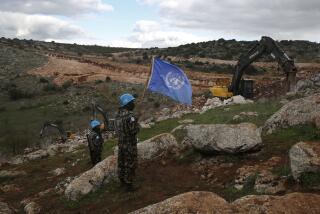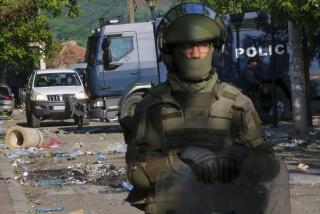Technical Team House-Hunting in Kosovo
- Share via
PRISTINA, Yugoslavia — Over the next few weeks, hundreds of foreign observers are due here in the war-ravaged Serbian province of Kosovo to start the hazardous job of making it safe for thousands of refugees to return. But before they can do that, they have to find safe places to live themselves.
A team of about 20 technical experts plans to travel across most of the province today to search for housing, office space and other basics for an expected 2,000 monitors.
That would be hard enough in the best of times, because Kosovo is one of the poorest places in Europe, but continuing battles between Serbian security forces and ethnic Albanian guerrillas add a dangerous complication.
“There will be a great deal of concern regarding security, and we will obviously try to be as aware as possible of the situation in any particular area at any time,” John Sandrock, the American chief of the technical team, said after arriving in Kosovo on Sunday.
“But we will not confront,” he added. “At least, I believe there will be no situation under which we will try to penetrate or go into an area that is insecure.”
Each day, however, brings reports of new attacks. Saturday night, three Serbian police officers died in a guerrilla grenade attack about 30 miles west of Pristina, the provincial capital. They were killed on a road that cuts through guerrilla territory, in one of several areas where Serbian police say rebels are attacking as security forces withdraw.
To get a complete look at Serbian forces in the province, the foreign observers will have to travel that route and many others that are just as dangerous.
The observers are part of a deal reached last week between the North Atlantic Treaty Organization and Yugoslav President Slobodan Milosevic to sharply reduce the number of Serbian security forces in Kosovo and enable up to 300,000 refugees to return home.
NATO has given Milosevic until Oct. 27 to either face air attacks or bring the number of police and army units down to the level they were at before the war escalated in February.
But the ethnic Albanian guerrillas, known as the Kosovo Liberation Army, didn’t sign the deal, don’t have a cease-fire agreement with the Yugoslav government and insist they will go on fighting for an independent Kosovo.
That means the unarmed monitors, including human rights workers, lawyers and experts on democracy, may find themselves crossing shifting front lines where enemies are still targeting each other.
Mission leaders haven’t decided whether they will try to assess blame if they witness attacks, said British Maj. Gen. John Drewienkiewicz, a mission member who got his job only Friday.
Most of the technical team will return to Vienna on Wednesday. About 15 to 20 other members of the mission are expected to arrive here the same day.
Their first task will be to set up the mission’s headquarters in Pristina, Drewienkiewicz said.
Although the weather has been unseasonably warm and dry over the last few days, the temperature drops sharply each night, and winter’s first snows are expected early next month. So the observers must hurry to keep refugees from freezing to death in mountain camps.
American U-2 spy planes started flying high above Yugoslavia on Saturday, but the observers have yet to work out such details as how to organize the teams.
“I’m not in a position to give you exact dates, times and numbers,” Sandrock said. “Those are still being decided on and worked on.
“I can assure you, though, that we will try to do this--and we will indeed do it--as quickly as we possibly can.”
In addition to its other difficulties, the mission may have trouble finding enough experts who are willing to suffer the risks and hardships in Kosovo, Drewienkiewicz said.
“If you are available quickly, then you are better than a nuclear scientist and a brain surgeon who’s available in six months’ time,” he said. “So the exact balance between generalists and specialists is going to vary.”
The mission’s members will come from any of 54 countries in the Organization for Security and Cooperation in Europe--which can make something as essential as their talking to one another difficult.
One of the logistics team’s biggest jobs will be to set up a field radio network to connect all the teams and NATO, which probably means buying a whole new system off the shelf, Drewienkiewicz said.
The mission’s human rights experts also will have to be in regular contact with nongovernmental groups already working in Kosovo to help investigate alleged abuses, he said.
“So there’s a lot of communications to set up, and that’s going to be technically difficult,” Drewienkiewicz said.
Purchasing decisions haven’t been made yet, but that doesn’t have to delay the monitors for long because the OSCE already has experience in Balkan hot spots such as Bosnia-Herzegovina, he added.
The OSCE “is not arriving in the Balkans blinking,” he said. “It’s actually been in the Balkans working hard for some time.”
Sandrock, meanwhile, refused to say whether the observer mission had either sought or received security guarantees from the guerrillas. He referred only to the signed agreement by Yugoslavia, in which Serbia is the dominant of two republics, to allow the mission free access for one year.
“Ours is a technical mission, and negotiations and discussions with various factions are not my job,” he said.
More to Read
Sign up for Essential California
The most important California stories and recommendations in your inbox every morning.
You may occasionally receive promotional content from the Los Angeles Times.













